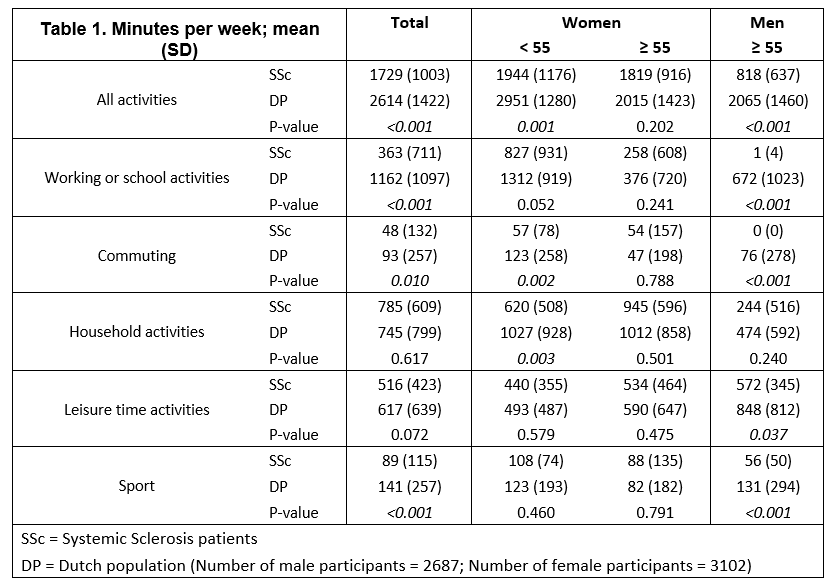Session Information
Session Type: ACR Poster Session B
Session Time: 9:00AM-11:00AM
Background/Purpose : Systemic sclerosis (SSc) is a condition with major consequences on many aspects of patient’s functioning. Whereas its impact on exercise capabilities and daily activities has been well described, the association between the disease and its severity and physical activity (PA) is largely unknown. The aim of this study was to compare PA levels of Dutch SSc patients to the Dutch population and study factors associated with PA levels and determine needs and preferences of SSc patients regarding PA.
Methods: 59 SSc patients referred to a multidisciplinary care pathway and fulfilling the ACR 19801 or LeRoy criteria2 for SSc completed the Short QUestionnaire to ASess Health-Enhancing PA3. The proportion of patients meeting the Dutch recommendation for PA (=moderate intensity PA for 30 minutes on > or = 5 days/week) and the total minutes of PA per week were calculated. Data were compared with aggregated data of the Dutch population (Central Bureau of Statistics; N=5789) and compared by means of t-tests. The following characteristics were extracted from the medical record: Body Mass Index, disease duration, modified Rodnan skin score, current or past immunosuppressive therapy, left ventricular ejection fraction, six minute walking distance, diffuse capacity for carbon monoxide, presence of anti-Scl-70-/ anti-centromere-antibodies, interstitial lung disease, proximal muscular weakness, synovitis, joint contractures or atrophy. The needs and preferences of SSc patients regarding PA were assessed by means of a self-developed questionnaire. Patients’ characteristics and needs and preferences were multivariately compared between patients with low and patients with high levels of PA (less or more than the average minutes/week of the Dutch population).
Results: Of the 59 included patients 52 (88%) were women. The median age was 65 years and 14 (24%) SSc patients were aged 55 years and below. Stratified for age (<55 or ≥55 years) and gender, the proportion of SSc patients meeting the Dutch recommendation for PA was not significantly different from the Dutch population. However, the total minutes of PA per week was significantly lower among SSc patients as compared with the Dutch population (1729 vs. 2614, Table 1). Multivariable analyses showed that male gender and joint/muscle involvement were associated with lower PA levels (p=0.044; p=0.013). Patients not meeting the Dutch recommendations more often reported pain during exercise and a lack of energy interfering with exercise (p=0.049; p=0.002). 39 (67%) patients stated to need more information about PA.
Conclusion: In SSc patients, the total number of minutes of physical activity per week is significantly lower as compared to the general population. Pain, lack of energy, male gender and joint/muscle involvement seem to interfere with exercise, underlining the need for proper guidance of systemic sclerosis patients by health care providers. References: 1Arthritis Rheum 1980 May;23(5):581–90. 2LeRoy E et al. J Rheumatol. 2001;28(7):1573–6. 3Wendel-Vos G et al. J Clin Epidemiol. 2003 56(12):1163–9.
To cite this abstract in AMA style:
de Vries-Bouwstra JK, Liem S, Ninaber MK, Ajmone Marsan N, Wolterbeek R, Meessen J, Vliet Vlieland T. Physical Activity in Patients with Systemic Sclerosis [abstract]. Arthritis Rheumatol. 2016; 68 (suppl 10). https://acrabstracts.org/abstract/physical-activity-in-patients-with-systemic-sclerosis/. Accessed .« Back to 2016 ACR/ARHP Annual Meeting
ACR Meeting Abstracts - https://acrabstracts.org/abstract/physical-activity-in-patients-with-systemic-sclerosis/

